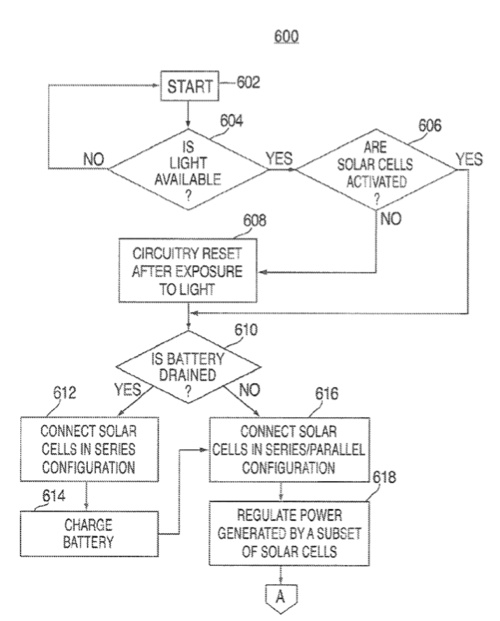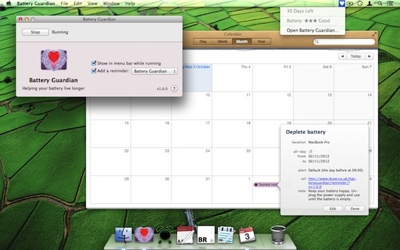Apple has been granted a patent (number 8022571) relating to power management circuitry and solar cells. The patent is directed to methods, systems, and apparatuses for implementing circuitry that can be used to control multiple solar cells to generate power for a portable electronic device.
For example, in response to determining that one or more of the solar cells is generating a reduce voltage output (e.g., due to a partial obstruction of one or more of the solar cells), the connections among the solar cells can be configured to generate a constant preset voltage, as long as a subset of the solar cells is operating. The voltage generated by the solar cells can then be boosted to a value suitable for powering the portable electronic device and/or any of its individual components.
As another example, the connections among the solar cells can be configured to generate a startup voltage to directly power the portable electronic device and/or any of its components. The inventors are Daniel A. Warren and Michael Rosenblatt.
Here’s Apple’s background and summary of the invention: “Portable electronic devices, such as cellular telephones, media players (e.g., music, video and/or audio players), and hybrid devices that combine telephone and media playing functionality are known. These devices are sometimes powered by rechargeable batteries such as nickel-cadmium, lithium-ion, nickel-metal hydride, and rechargeable alkaline batteries.
“The batteries of such devices are often recharged using standard recharging means and methods. For example, the battery of a device can be recharged by plugging a charger into the device and into a conventional alternating current (AC) outlet. As another example, the battery of a device can be charged by plugging the device into another electronic device using a universal serial bus (USB) connection (such as a USB cable or docking station).
“However, it may be inconvenient for the user to charge the batteries when, for example, the user is on the road. In addition, a typical recharge will power the battery for only a limited amount of run time (e.g., 10 to 24 hours). After the battery has been drained, the user must recharge or replace the battery to continue using the portable electronic device.
“Some portable electronic devices (e.g., calculators) may use solar cells to power the device. Because of the small size of these portable electronic devices, however, the number of solar cells that can be placed on the device is limited. Consequently, while the voltage generated by the solar cells may be enough to power less energy demanding devices, the voltage may be insufficient for portable electronic devices that demand more power.
“Furthermore, as an increasing number of advanced features are packed into these portable electronic devices, larger power sources (e.g., larger batteries and more solar cells) are required to power the devices. Thus, there are competing interests between the portability of these devices and the amount of available power.
“This invention can relate to methods, systems, and apparatuses for powering a portable electronic device using one or more solar cells. The portable electronic device may be an iPod or iPhone, or any other suitable media device. The solar cells can generate electrical power in response to being exposed to light energy.
“In some cases, the amount of voltage and/or current generated by the solar cells may not be enough to power the portable electronic device. Thus, in some embodiments, boost circuitry powered by a battery and/or the solar cells can regulate the power generated by the solar cells. The boosted power can then be used to power other components of the portable electronic device.
“In addition, the portable electronic device can include circuitry (e.g., bootstrap circuitry) which can monitor the state of the battery. If the battery is not drained (e.g., battery is generating energy above a predetermined minimum threshold), the circuitry can connect the solar cells in a series/parallel configuration, which can allow the solar cells to generate a constant preset voltage as long as a subset of the solar cells is operating.
“This configuration may thus provide protection by allowing the solar cells to continue powering the portable electronic device even if the solar cells are partially obstructed. In the series/parallel configuration, a subset of the solar cells (e.g., pairs of solar cells) can be connected in a parallel configuration to form parallel groups. Each of the parallel groups can then be connected in series.
“In the event that the battery is drained (e.g., battery is generating energy below a predetermined minimum threshold), the boost circuitry can not be powered by the battery. In such circumstances, the invention can connect the solar cells in a series configuration that facilitates the generation of a startup voltage sufficient to power the portable electronic device.
“The startup voltage can be configured to be higher than the voltage generated by the solar cells in the series/parallel configuration. In some cases, the solar cells can also be used to directly power the boost circuitry when the solar cells are connected in the series configuration. As a result, the boost circuitry can continue to regulate the power generated by the solar cells even when the battery is drained.
“In some embodiments, while the solar cells are connected in the series configuration, surplus energy (e.g., generated energy that exceeds the load of the portable electronic device) can be used to charge the battery if the battery is not fully charged (e.g., the battery is generating energy at or below an operating threshold, which can be higher than or the same as the predetermined minimum threshold). The circuitry can detect when the battery has been charged to a value suitable for powering the boost circuitry (e.g., a value that exceeds the operating threshold). Once the battery is charged to a suitable value, the circuitry can connect the solar cells in the series/parallel configuration to provide protection from the partial obstruction of the solar cells.
“In order to automatically reconfigure the solar cells in different configurations (e.g., series and series/parallel configurations), switches can be placed between the solar cells, a power plane (e.g., V.sub.OUT), and/or a ground plane. The individual switches can then be opened and/or closed, thereby connecting the solar cells in either the series/parallel or series configuration. In some embodiments, the switches can be selected such that their normal operating states (e.g., inactive states that require no input power) can automatically connect the solar cells in the series configuration (e.g., in the event that the circuitry is not operating because of the drained battery).
“In some embodiments, the circuitry can actively detect partial obstructions and can automatically reconfigure the flow of electricity generated by the solar cells around the partial obstructions. Thus, using a matrix of switches, a subset of the solar cells that are not obstructed can be configured to generate a constant preset voltage for powering the portable electronic device.
“Therefore, in accordance with the invention, there is provided methods, systems, and apparatuses for powering a portable electronic device using one or more solar cells. The connections among the solar cells can be configured such that a constant preset voltage is generated as long as a subset of the solar cells is operating. In addition, the solar cells can be configured to generate a startup voltage and/or directly power the portable electronic device without the need for additional components (e.g., the need for a battery and/or boost circuitry).”
— Dennis Sellers



